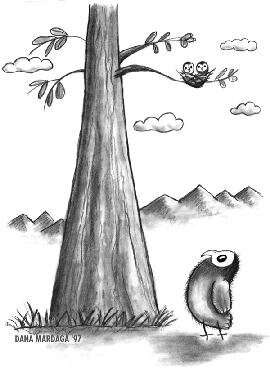
Board of Directors:
President
Martha Kudlacik
Vice-President Operations
Courtenay Dawson-Roberts
Vice-President Education
Sally Peck
Vice-President Publicity
Jeri Flinn
Treasurer
Debbie Schide
Secretary
Beth Visbeck
Director-at-Large Fundraising
Mina Reale
Director-at-Large Fundraising
Lauren Black
Director-at-Large Fundraising
Denise Connell-Godwin
Director-at-Large Fundraising
Janet Goy
Past President
Brad Milliken
Clinical Advisor
Susie Brain
The Rescuer:
Editor
Lisa Stahr
Designer
Nancy Rubin
Initial Design by
Marty Johnson
Illustrators
Dana Mardaga
Debbie Melmon
Contributors
Martha Kudlacik
Shannon McFarlin
Nancy Rubin
The Rescuer
Volume XXIII -- Issue Two -- Summer 1997
SUCCESS STORY: The Early Bird ...
by Kappy Sprenger
For a long time, rehabbers have encouraged the public to return baby birds to their nests or parents. If this could not be accomplished, we rehabbers would raise the youngsters ourselves, returning them to the wild when we felt they could survive on their own. This often meant weeks of time in captivity for the birds, while muscles strengthened, flying and feeding skills developed, and so forth-all things better done under the parents' wings, so to speak, than ours. Last year, we tried out an "early return" program with Crows-rehabbing them for a short time until they were able to return to the nest on their own-and found it worked well. This year, we decided to give a try with Barn Owls, if the opportunity arose and conditions were right.

Our chance came when a young Barn Owl fell from a very tall eucalyptus tree on a small ranch. It wasn't possible for humans to return him to the nest, but if we could safely hurry him along, perhaps he could return himself-before he was fully able to be on his own and before his siblings fledged. The ranchers who found him said they would be delighted to keep us up-to-date on all owl activity in the meantime.
A young male, the Barn Owl was healthy and of good weight, well-feathered but still somewhat downy. His appetite was excellent despite being moved, within less than ten days, from an airline carrier to a small aviary to an intermediate-sized aviary to a long flight aviary. After four nights in the large aviary, he not only flew confidently and strongly, but he also had learned to land with assurance. When approached by humans he chose flight over running, hiding, or attacking. He progressed so rapidly, in fact, that we offered live mice in a large container in addition to his normal non-living fare.
Two weeks after his admission to Wildlife Rescue, we brought the young owl back to the ranch, arriving about 15 minutes before we expected the adults to start hunting. Choosing our release site as just below the nest tree, we pointed the box towards a low wooden fence, well in sight of the nest and its occupants. The youngster would have to reach the nest in stages as he wasn't strong enough to fly directly to it.
Almost immediately, the young owl flew from the box, staying very low until he reached the fence, about 60 feet away. Within minutes, he flew to a nearby, higher fence, letting out a sharp scream as he did. He had hardly landed when we saw the silent shape of a large Barn Owl glide over him, then continue on out of sight in the darkening sky. We then moved away from the nest tree to a less obvious vantage point-and one that took us out of sight of "our" owl.
For the next ten minutes, we watched both adults come and go from the nest, heard them call as they arrived with food, and listened to the young in the tree chitter in response. We wondered about our owl, where he'd gone....
Then, as one of the adults flew to the tree, a smaller, not-too-sure shape followed. For a moment he faltered, high up in the air, then his wings beat frantically and he continued on, disappearing into the shadows of the branches after his parent. Home.
We stayed just a little longer. Everything at the nest had returned to normal, and we were getting cold-despite a very warm glow within.



 Through these doors
Through these doors
 Next Issue
Next Issue